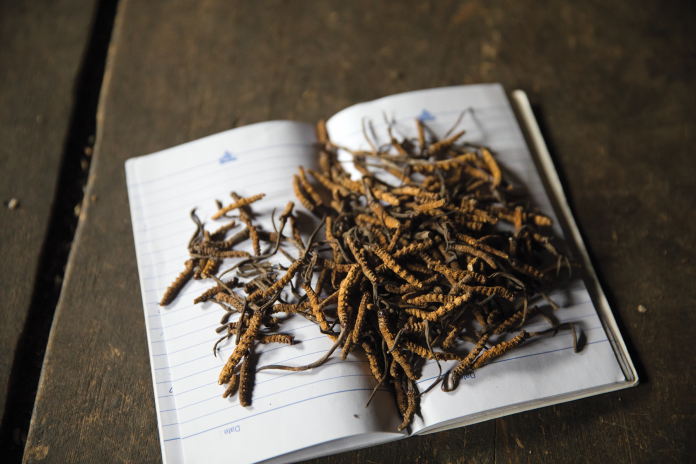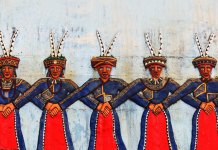The parasitic fungi that spawned a decade-long, Nepali gold rush may soon die out thanks to climate change
Text and Photos Tanya Sharapova
A heaving storm lashes at the bent backs of 200 hopefuls as they scrabble at the earth. Crawling on all fours under pouring skies – some mothers with blanketed babies strapped to their backs – their nimble fingers unearth caterpillar-like brown roots in shades of yellow, white, and black. The yellow ones are worth the most. But a Layap will settle for any one, spending weeks on the steep mountainside to excavate them, clean them with toothbrushes, and tote them off to auctions in Gasa, where buyers await.

Traditionally, Bhutan’s semi-nomadic people were yak rearers, spending their days tending herds some 4,000 metres above sea level. But a decade ago, a new practice was born: For a month in June, entire families ascend even higher up the Himalayas to harvest yartsa gunbu (meaning “summer insect, winter plant”), the local name for cordyceps. Gathering the coveted medicinal plant is prohibited for most of Bhutan’s population, except 1,200 inhabitants of seven villages, including the Layap, under a 2004 royal decree designed to supplement highlanders’ income on top of sales of yak meat and dairy.

But cordyceps commands a price of up to USD42,000 per kilo, and this eye-popping price tag has led some Layap to change their age-old traditions: When a single trip can feed a family for a whole year, why should they still shepherd? “I would have continued picking cordyceps if I hadn’t been told that my daughter was born,” says Tashi, the Laya village headman’s son-in-law. “I only came down from the mountains for a few days to see my wife and baby. The weather is ghastly, with strong wind and rain, but we are still harvesting with enthusiasm.”

To reach cordyceps grounds, a Layap must hike slippery paths, cross rivers and wend through forest, eating and sleeping under tarp between a rock and a tree branch amid torrid weather. But with all that mountainous yak-rearing, perhaps no people are better equipped to gather this fungus, whose sales have since made them the richest community in the country. Chinese, American and Japanese buyers clamour for the “Himalayan Viagra” to make tonics, while it is to locals a medicine and household remedy.

But not all Layap have been swept up in the cordyceps craze. Some, like Wangmo, still herd: Each yak in her flock of 49 has a name, and her son sells their butter and cheese at Punakha, the closest big city. “I’m absolutely uninterested in that expensive caterpillar,” says the middle-aged Layap, who is wearing a flowery blouse and black skirt made from yak wool. “I like constantly moving from one pasture to another. I can’t imagine life without my yaks.”
Perhaps Wangmo is onto something. Experts – and the Bhutan government – have observed that the quantity and quality of cordyceps in the Himalayas has been decreasing with each passing year. Global warming threatens the longevity of this fungus, throwing into question how long the Layap’s new tradition can stick around for.
Related: The Tree Man
Related: Uncharted Territories
Related: Grub’s Up!
For more stories and photographs from this issue, see Asian Geographic Issue 130, 2018




![The Road to Independence: Malaya’s Battle Against Communism [1948-1960]](https://asiangeo.com/wp-content/uploads/2021/07/WhatsApp-Image-2021-07-26-at-11.07.56-AM-218x150.jpeg)






